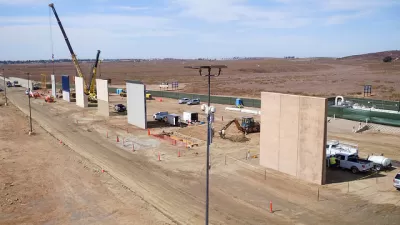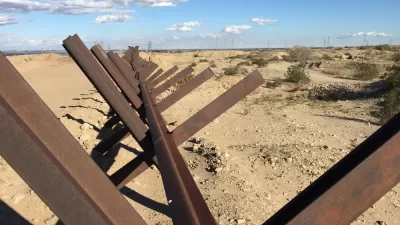In the drive to begin construction in New Mexico, the Trump Administration has bypassed dozens of federal environmental regulations.

This week, the Department of Homeland Security “announced that it would be waiving more than 30 laws, most of them environmental, to begin construction on a 20-mile-long stretch of bollard wall near the Santa Teresa port on the U.S.-Mexico border.”
Those laws include pieces of the legislation that make up the foundation of federal environmental protection, including the National Environmental Protection Act, the Clean Air Act, the Clean Water Act, and the Endangered Species Act.
Under the 2005 REAL ID Act, DHS Secretary Kirsten Nielsen has the right to waive any federal, state or local law to expedite construction in the border region, and this is not the first time she’s done so. Though the administration has not been particularly forthcoming about plans for the wall, the AP has reported that there are no plans for environmental review, and the Texas Observer has reported that at least part of it will bisect the Santa Ana Wildlife Refuge.
The potential for “ecological disaster,” however, has been established by both news organizations and the Army Corps of Engineers.
The Trump Administration has demonstrated a disregard for federal environmental regulation from the start, but this round of waivers also applies to parts of the American Indian Religious Freedom Act, Native American Graves Protection and Repatriation Act, and the National Historic Preservation Act.
FULL STORY: Trump administration waives over 30 laws to jumpstart border wall construction

Study: Maui’s Plan to Convert Vacation Rentals to Long-Term Housing Could Cause Nearly $1 Billion Economic Loss
The plan would reduce visitor accommodation by 25,% resulting in 1,900 jobs lost.

North Texas Transit Leaders Tout Benefits of TOD for Growing Region
At a summit focused on transit-oriented development, policymakers discussed how North Texas’ expanded light rail system can serve as a tool for economic growth.

Why Should We Subsidize Public Transportation?
Many public transit agencies face financial stress due to rising costs, declining fare revenue, and declining subsidies. Transit advocates must provide a strong business case for increasing public transit funding.

How to Make US Trains Faster
Changes to boarding platforms and a switch to electric trains could improve U.S. passenger rail service without the added cost of high-speed rail.

Columbia’s Revitalized ‘Loop’ Is a Hub for Local Entrepreneurs
A focus on small businesses is helping a commercial corridor in Columbia, Missouri thrive.

Invasive Insect Threatens Minnesota’s Ash Forests
The Emerald Ash Borer is a rapidly spreading invasive pest threatening Minnesota’s ash trees, and homeowners are encouraged to plant diverse replacement species, avoid moving ash firewood, and monitor for signs of infestation.
Urban Design for Planners 1: Software Tools
This six-course series explores essential urban design concepts using open source software and equips planners with the tools they need to participate fully in the urban design process.
Planning for Universal Design
Learn the tools for implementing Universal Design in planning regulations.
City of Santa Clarita
Ascent Environmental
Institute for Housing and Urban Development Studies (IHS)
City of Grandview
Harvard GSD Executive Education
Toledo-Lucas County Plan Commissions
Salt Lake City
NYU Wagner Graduate School of Public Service





























